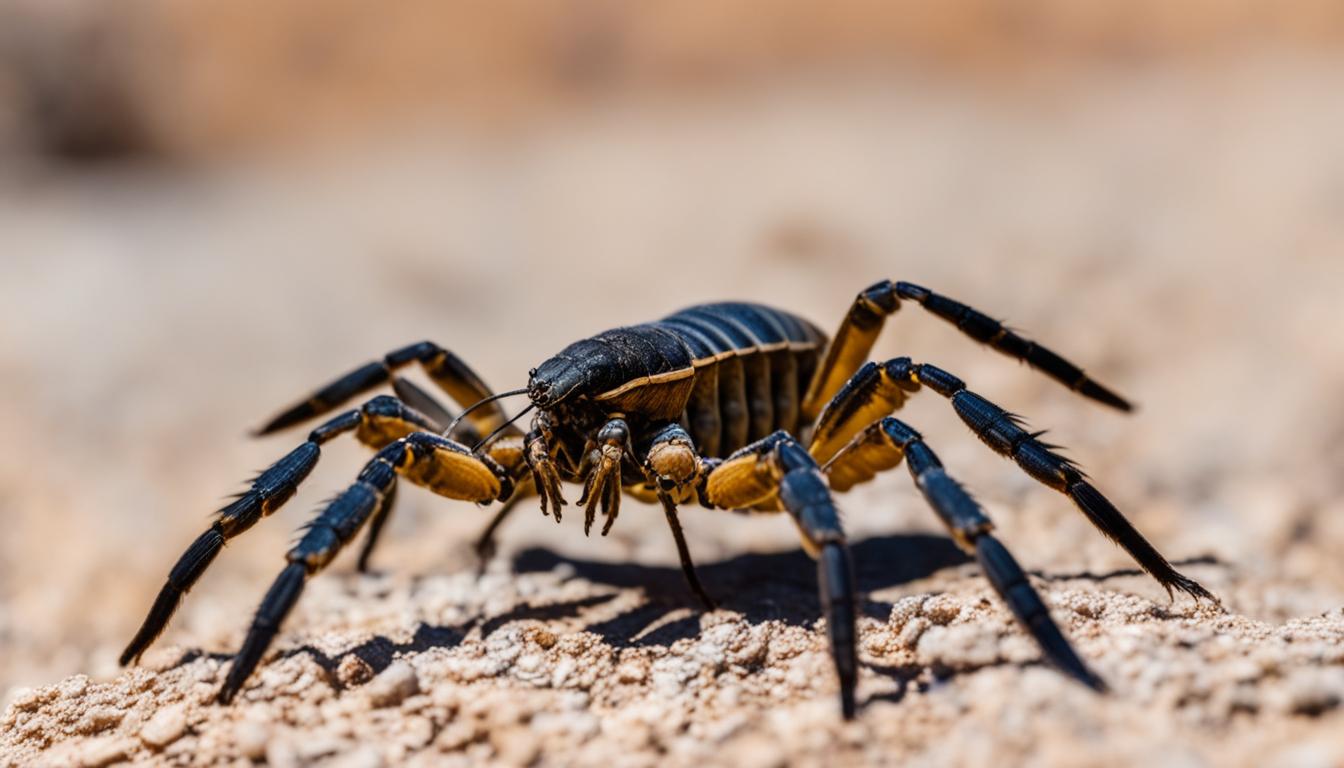Did you know the giant desert hairy scorpion is the biggest scorpion in North America? It can grow up to 14 cm long. It’s found in the Sonoran and Mojave deserts, in places like Arizona, Utah, and Nevada. This scorpion is dark with yellow parts and many sensing hairs. It’s important for the desert’s life.
There are 8-9 kinds of Hadrurus scorpions in the US. The giant desert hairy scorpion is the most famous. It hunts at night and its venom isn’t very deadly. It stings to catch small bugs, lizards, and sometimes tiny animals. These scorpion’s stings can hurt like a bee’s but are not too bad for people.
The giant desert hairy scorpion lives in very tough places in the deserts of the US. Its looks and how it hunts are interesting to scientists and people who love nature. Learning more will show us amazing things about this special scorpion.
Arizona Desert Hairy Scorpion Names
Usually, the name “Arizona Desert Hairy Scorpion” designates only one species:
The species also known as the Giant Desert Hairy Scorpion or the Arizona Desert Hairy Scorpion has this scientific name. It is indigenous to the deserts of northwest Mexico and the southwest United States.
Although there aren’t many species of “Arizona Desert Hairy Scorpions,” the genus Hadrurus does have similar species that may be found in dry parts of North America. The following is a list of all known Hadrurus species:
The hairy scorpion of the Arizona desert, Hadrurus arizonensis
- Hadrurus spadix: The Scorpion with Black Hair
- Hadrurus obscureus
- Pinteri Hadrurus
- Hadrurus multicolored
- Hadrurus hirsutus
While all of these species are distributed across western North America’s deserts and arid areas, only H. arizonensis is known to be exclusively linked with Arizona, where it is known as the “Arizona Desert Hairy Scorpion.”
Unveiling the Giant Desert Hairy Scorpion
Identification and Appearance
The giant desert hairy scorpion is an amazing arachnid. It’s found in Arizona’s dry lands. This scorpion is named for its big size and lots of hair on its body. It can grow up to 7 inches, making it the biggest scorpion in North America.
It has a dark body with yellow legs, claws, and tail. Its huge claws are great for catching and crushing food. The stinger on its tail keeps it safe. Lots of hairs help it smell chemicals and feel air movement. This helps it find food easily.
These big scorpions come out at night. They look for insects, spiders, and even small lizards or mammals. Their size and looks are very interesting in the Arizona desert.
The giant desert hairy scorpion is very special among Arizona’s many scorpions. It lives in a tough desert but survives well. Scientists and people like learning about its special features and how it lives.
Characteristics and Habitats of Arizona Desert Scorpions
The Arizona desert has many types of scorpions. Each scorpion has its own characteristics that help it survive. The giant desert hairy scorpion, known as Hadrurus arizonensis, is one of the biggest. It can have a leg span up to 6 inches (15 cm).
Other venomous scorpions live in the Arizona desert too. For example, there is the Bark scorpion (Centruroides exilicauda) and the Striped bark scorpion (Centruroides vittatus). These scorpions are known for their strong venom. People often see them in the area.
The Striped tail scorpion, or the Arizona hairy scorpion, is also common here. It stands out with its striped tail. This scorpion lives in many desert places, like rocks and sand.
| Scorpion Species | Common Names | Venom Potency | Habitat |
|---|---|---|---|
| Hadrurus arizonensis | Giant desert hairy scorpion, Arizona hairy scorpion, Striped tail scorpion | Low, not harmful to humans unless allergic | Desert regions of the southwestern United States |
| Centruroides exilicauda | Bark scorpion | Potent, potentially life-threatening | Arid and semi-arid regions of the southwestern United States |
| Centruroides vittatus | Striped bark scorpion | Potent, but less dangerous than the bark scorpion | Arid and semi-arid regions of the southwestern United States |
| Vaejovis spinigerus | Striped tail scorpion, Devil’s scorpion | Mild, not considered a threat to humans | Arid and semi-arid regions of the southwestern United States |
These scorpion types live in different places across the Arizona desert. You may see them on rocks or in sandy areas. While some are not risky for humans, others with strong venom like the bark scorpion should be careful around.
Conclusion
The giant desert hairy scorpion is an interesting arachnid found in the southwestern United States. Particularly in Arizona, you can spot these scorpions. They are big, up to 7 inches, with dark bodies and yellowish legs. They have many hairs to feel and catch their food.
Their bite is painful but not deadly to humans. It can make you swell up and hurt for a while. These scorpions help balance their home by eating other bugs and being food for bigger animals.
To live well with these scorpions, people in Arizona can do a few things. They should keep their houses closed off and not too messy outside. Good lighting helps, too. These steps lower the chance of bumping into a scorpion while keeping the desert healthy.
Learning about scorpion species in the Southwest is exciting. Scorpions like the giant desert hairy scorpion show us how life finds a way to survive. We should take care of them and make sure they keep living in their dry homes.

